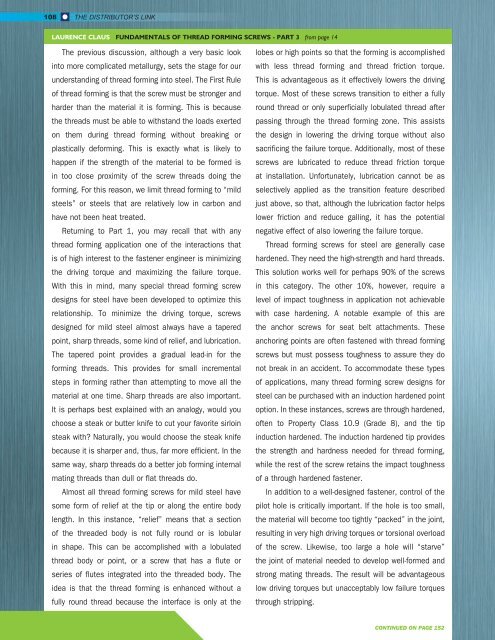SPRING 2017
Distributor's Link Magazine Spring Issue 2017 / Vol 40 No2
Distributor's Link Magazine Spring Issue 2017 / Vol 40 No2
Create successful ePaper yourself
Turn your PDF publications into a flip-book with our unique Google optimized e-Paper software.
108<br />
THE DISTRIBUTOR’S LINK<br />
LAURENCE CLAUS FUNDAMENTALS OF THREAD FORMING SCREWS - PART 3 from page 14<br />
The previous discussion, although a very basic look<br />
into more complicated metallurgy, sets the stage for our<br />
understanding of thread forming into steel. The First Rule<br />
of thread forming is that the screw must be stronger and<br />
harder than the material it is forming. This is because<br />
the threads must be able to withstand the loads exerted<br />
on them during thread forming without breaking or<br />
plastically deforming. This is exactly what is likely to<br />
happen if the strength of the material to be formed is<br />
in too close proximity of the screw threads doing the<br />
forming. For this reason, we limit thread forming to “mild<br />
steels” or steels that are relatively low in carbon and<br />
have not been heat treated.<br />
Returning to Part 1, you may recall that with any<br />
thread forming application one of the interactions that<br />
is of high interest to the fastener engineer is minimizing<br />
the driving torque and maximizing the failure torque.<br />
With this in mind, many special thread forming screw<br />
designs for steel have been developed to optimize this<br />
relationship. To minimize the driving torque, screws<br />
designed for mild steel almost always have a tapered<br />
point, sharp threads, some kind of relief, and lubrication.<br />
The tapered point provides a gradual lead-in for the<br />
forming threads. This provides for small incremental<br />
steps in forming rather than attempting to move all the<br />
material at one time. Sharp threads are also important.<br />
It is perhaps best explained with an analogy, would you<br />
choose a steak or butter knife to cut your favorite sirloin<br />
steak with? Naturally, you would choose the steak knife<br />
because it is sharper and, thus, far more efficient. In the<br />
same way, sharp threads do a better job forming internal<br />
mating threads than dull or flat threads do.<br />
Almost all thread forming screws for mild steel have<br />
some form of relief at the tip or along the entire body<br />
length. In this instance, “relief” means that a section<br />
of the threaded body is not fully round or is lobular<br />
in shape. This can be accomplished with a lobulated<br />
thread body or point, or a screw that has a flute or<br />
series of flutes integrated into the threaded body. The<br />
idea is that the thread forming is enhanced without a<br />
fully round thread because the interface is only at the<br />
lobes or high points so that the forming is accomplished<br />
with less thread forming and thread friction torque.<br />
This is advantageous as it effectively lowers the driving<br />
torque. Most of these screws transition to either a fully<br />
round thread or only superficially lobulated thread after<br />
passing through the thread forming zone. This assists<br />
the design in lowering the driving torque without also<br />
sacrificing the failure torque. Additionally, most of these<br />
screws are lubricated to reduce thread friction torque<br />
at installation. Unfortunately, lubrication cannot be as<br />
selectively applied as the transition feature described<br />
just above, so that, although the lubrication factor helps<br />
lower friction and reduce galling, it has the potential<br />
negative effect of also lowering the failure torque.<br />
Thread forming screws for steel are generally case<br />
hardened. They need the high-strength and hard threads.<br />
This solution works well for perhaps 90% of the screws<br />
in this category. The other 10%, however, require a<br />
level of impact toughness in application not achievable<br />
with case hardening. A notable example of this are<br />
the anchor screws for seat belt attachments. These<br />
anchoring points are often fastened with thread forming<br />
screws but must possess toughness to assure they do<br />
not break in an accident. To accommodate these types<br />
of applications, many thread forming screw designs for<br />
steel can be purchased with an induction hardened point<br />
option. In these instances, screws are through hardened,<br />
often to Property Class 10.9 (Grade 8), and the tip<br />
induction hardened. The induction hardened tip provides<br />
the strength and hardness needed for thread forming,<br />
while the rest of the screw retains the impact toughness<br />
of a through hardened fastener.<br />
In addition to a well-designed fastener, control of the<br />
pilot hole is critically important. If the hole is too small,<br />
the material will become too tightly “packed” in the joint,<br />
resulting in very high driving torques or torsional overload<br />
of the screw. Likewise, too large a hole will “starve”<br />
the joint of material needed to develop well-formed and<br />
strong mating threads. The result will be advantageous<br />
low driving torques but unacceptably low failure torques<br />
through stripping.<br />
CONTINUED ON PAGE 152

















